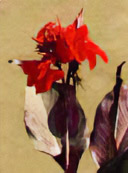Canna
- This tall perennial has large, broad leaves and a long stem which bears several white, yellow, orange or red flowers.
- Cannas love the sun and will require rich soil that isn't too high in nitrogen.
- They need to be kept well watered but not soggy.

- After the last spring frost, plant rhizomes just below the surface 12 to 18 inches (30 to 45 cm) apart.
- Cannas do not require thinning if they are planted far enough apart. Remember, they grow quite large.
- They will grow between 3 to 4 feet tall (0.9 to 1.2 m).
- In the fall, after the first light frost darkens the leaves, cut off the stems and dig out the rhizomes. Gently brush off any dirt. They can be saved indoors and replanted year after year.
- Allow them to dry and store them in a cardboard box in a cool place at around 50°F (10°C) until you want to replant them in the spring.
Fascinating Facts!
- Canna is a genus of plants that includes 10 species of flowering plants.
- Canna plants are native to tropical and subtropical regions of the Americas, although they are now grown worldwide as ornamental plants.
- The canna plant's leaves are large and paddle-shaped, and come in a variety of colors, including green, purple, and variegated.
- Canna plants are grown not only for their attractive foliage but also for their beautiful flowers, which range in color from red and orange to yellow and pink.
- Some species of canna plants are edible and are used in traditional medicines to treat a variety of ailments.
- Canna plants have been cultivated for thousands of years and were used by ancient civilizations such as the Aztecs and Incas for their medicinal and ornamental properties.
- The name "canna" is derived from the Latin word for "reed" or "cane," referring to the plant's tall and sturdy stems.
more flowers
caring
|





